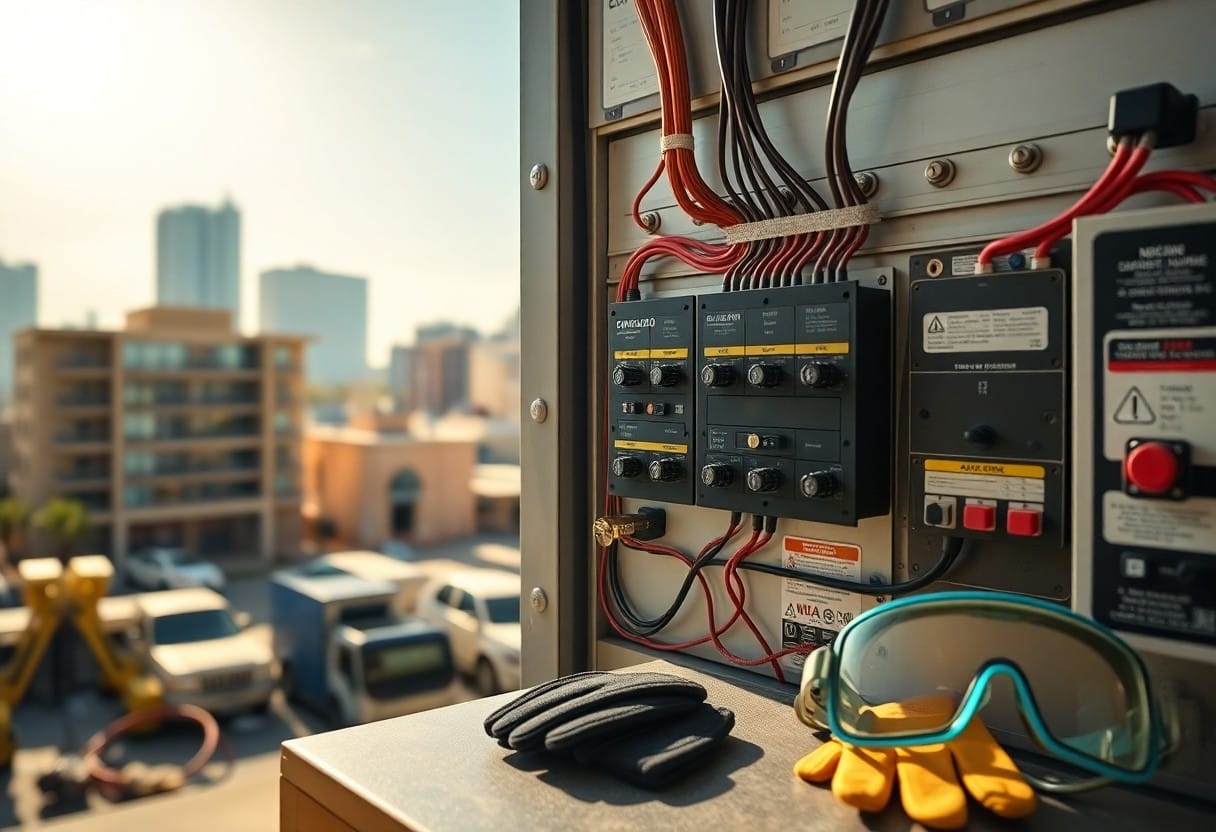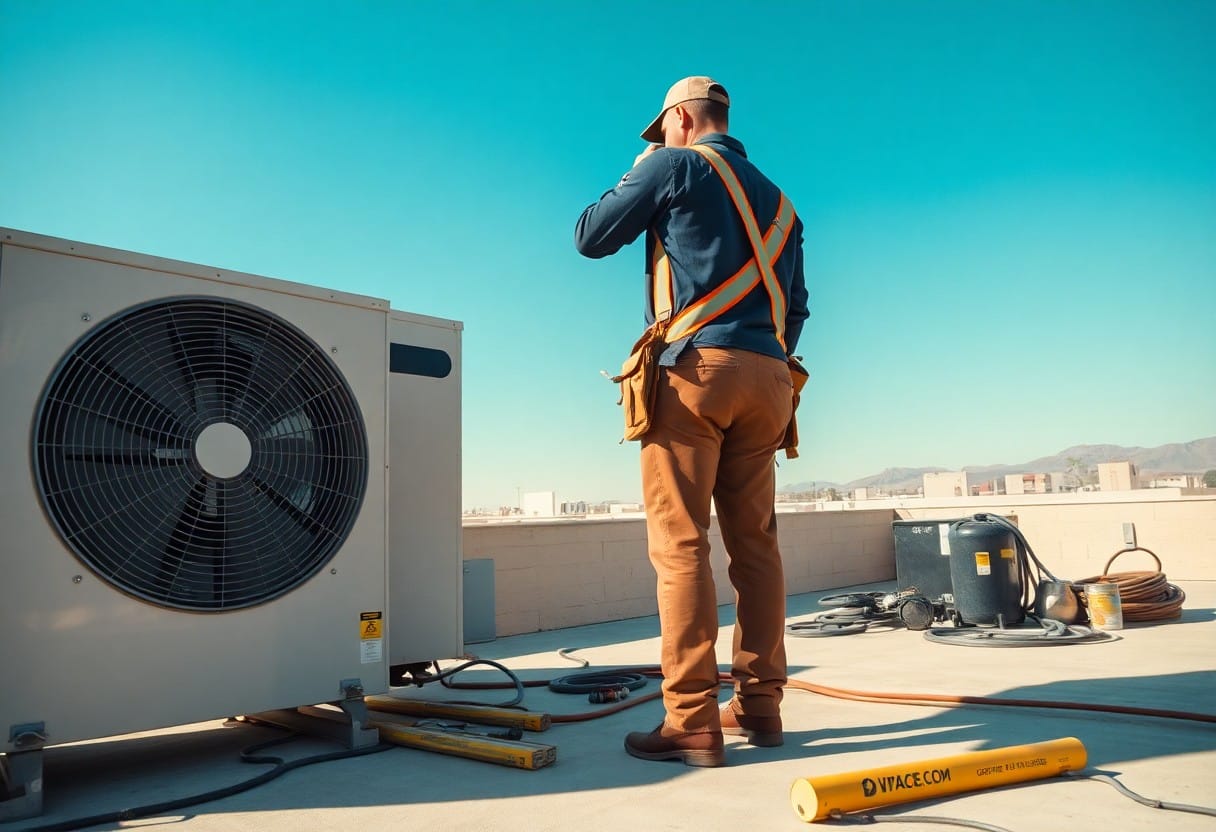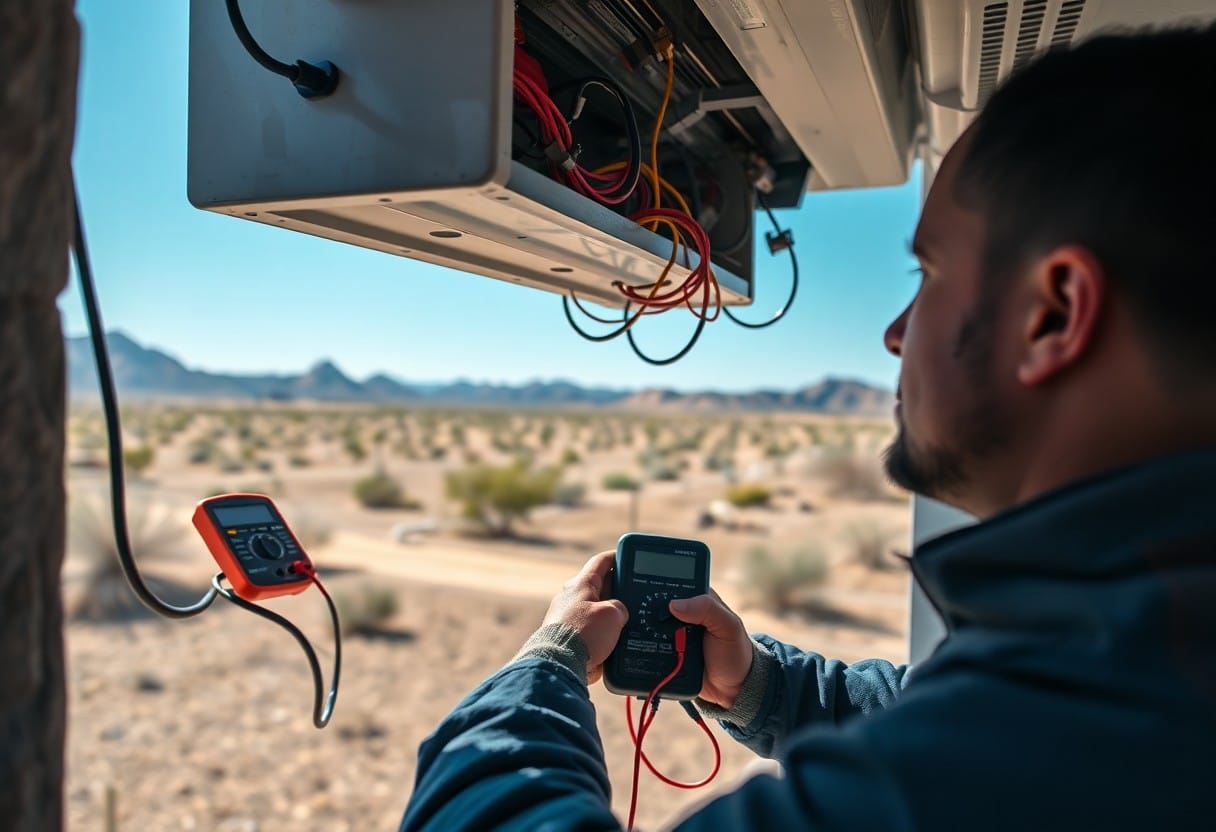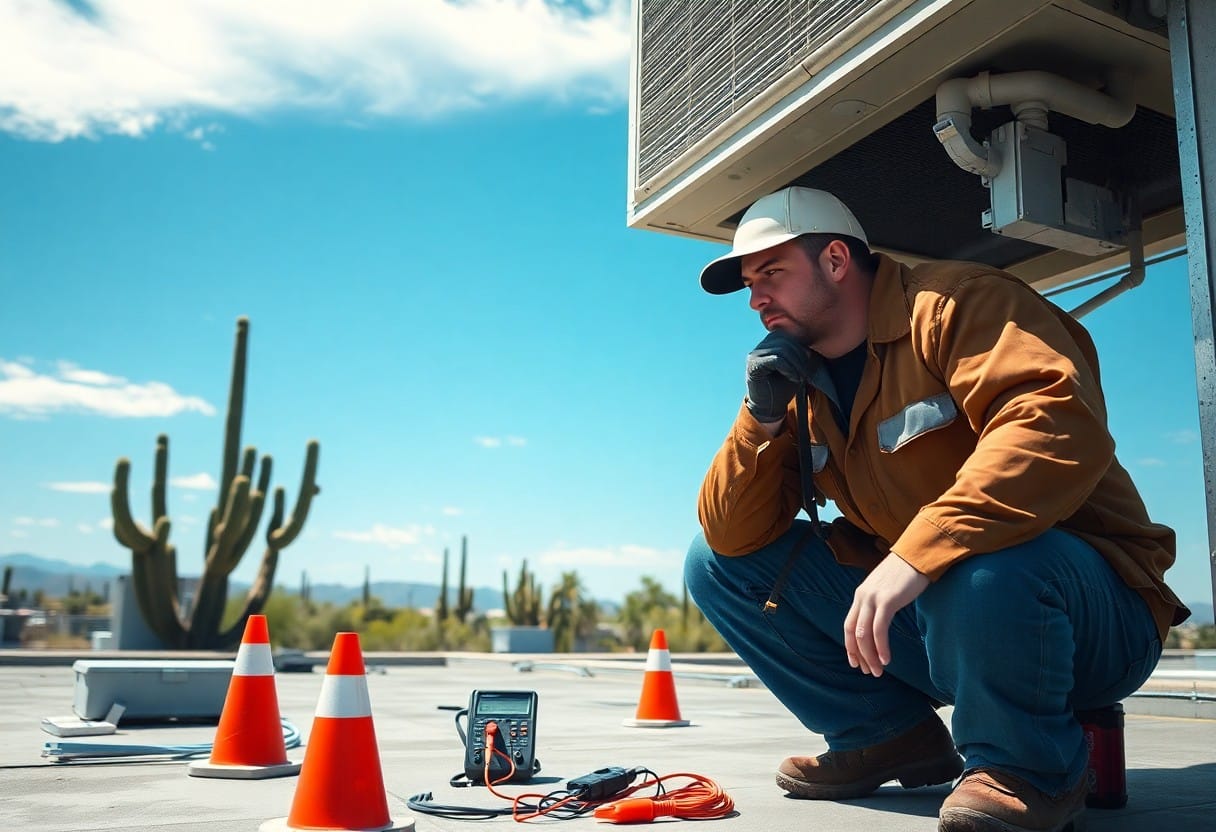It’s important for you to understand the potential hazards of HVAC electrical issues in Phoenix, especially during extreme weather conditions. These problems can pose serious safety risks to you and your family, including fire hazards and electrical shocks. This post will guide you through imperative emergency safety measures and the appropriate repair protocols for your HVAC system, ensuring your home remains safe and comfortable when unexpected issues arise.
Many homeowners in Phoenix face potentially hazardous HVAC electrical issues that require immediate attention. Understanding these risks and knowing how to respond can safeguard your home and family from electrical fires or system failures. You should prioritize safety measures and be prepared to implement effective repair protocols for any emergency. This guide will equip you with necessary information for navigating electrical problems efficiently, ensuring your HVAC system operates safely and effectively.
Understanding HVAC Systems
Components of HVAC Systems
Every HVAC system comprises several key components that work together to maintain indoor comfort. The thermostat acts as the control center, signaling the system when to heat or cool. The furnace and air conditioner play significant roles in temperature regulation, while the blower fan circulates air throughout your space. Additionally, ductwork is crucial for transporting conditioned air, while insulation ensures that energy is not wasted in the process.
You may also find the compressor critical in air conditioning systems, as it pumps refrigerant through the coils to remove heat from the air. Furthermore, a heat exchanger effectively transfers heat from the furnace to the air, ensuring efficient heating. Understanding these components helps you identify potential issues and the overall performance of your HVAC system.
Common Electrical Issues in HVAC
Electrical problems often plague HVAC systems, creating disturbances in their operation. One common issue involves faulty <strong{thermostats, which can prevent the system from receiving proper signals, thus inhibiting temperature adjustments. Additionally, disconnect switches can fail, leading to power interruptions that render your system inoperable. Challenges with the capacitor—vital for starting the compressor and fan motors—may also cause system malfunctions, leading to inefficient performance or complete breakdowns.
Wiring issues pose another significant risk, especially with older HVAC systems that may have degraded insulation or loose connections. The potential for electrical shorts can also lead to dangerous situations, including fires. Regular inspections and timely repairs help prevent these problems, ensuring that your HVAC system operates optimally.
Electrical issues can manifest in various forms. For instance, increased energy bills might indicate that your HVAC system is not running efficiently due to electrical faults. If the circuit breaker trips frequently, it suggests an overload or short circuit within the system. Understanding these signs can prompt you to seek professional assistance before minor issues escalate into costly repairs or safety hazards.

Common HVAC Electrical Issues
Tripped Circuit Breakers
Tripped circuit breakers frequently indicate an underlying electrical problem with your HVAC system. When your breaker trips, it cuts off power to your unit to prevent overheating or potential fire hazards. For you, this may mean that your system is drawing too much current due to a malfunction, such as a short circuit, loose wiring, or compressor issues. If this happens repetitively, it’s vital to address it quickly; continual tripping not only disrupts your comfort but can also lead to further electrical complications.
Assessing the situation involves checking the breaker panel for any signs of overheating or odor, as well as inspecting your HVAC units for visible wear or signs of damage. It’s advisable to avoid resetting the breaker multiple times without consulting a professional. Seeking an expert’s insight will help diagnose whether it’s a simple fix or a sign of a more serious electrical failure.
Faulty Thermostats
A faulty thermostat can severely impact your HVAC system’s efficiency and operation. If your thermostat is malfunctioning, it may not read the correct temperature, leading to erratic heating or cooling cycles. This not only affects your comfort but can also result in higher energy bills as your system works harder to compensate for the inaccurate readings. You may notice issues like the system running continuously or not operating at all, which can be frustrating and costly.
To determine if your thermostat is faulty, check for calibrations, battery issues, or incorrect settings. If you notice inconsistent temperatures throughout your home, it might require recalibration or possibly full replacement. Taking the time to resolve thermostat issues can dramatically enhance your system’s performance and longevity, ensuring it operates within designed parameters.
Thermostats can either be mechanical or digital, and both types have their potential pitfalls. Mechanical thermostats might require manual adjustment, leading to inaccuracies over time, while digital models may need a software update or recalibration. In either case, maintaining a reliable thermostat translates to a more regulated indoor climate, leading to potential savings on energy costs and improved comfort levels.
Signs of Electrical Problems
Warning Signs to Look For
Your HVAC system can exhibit various warning signs indicating electrical issues that require immediate attention. A common indicator is the presence of burnt or frayed wires, which can often be detected during routine inspections. If you notice unusual buzzing or humming noises coming from your unit, these sounds might signal electrical faults that could lead to serious malfunctions. Additionally, frequent tripping of circuit breakers specifically linked to your HVAC system should not be overlooked, as this can point to overloads or short circuits that compromise the safety of your home.
Another red flag is inconsistent temperature control—if your system struggles to maintain the set temperature or frequently overshoots, it may be due to faulty electrical connections. You should also be alert to any unexpected spikes in your energy bills, as these can indicate that your system is operating inefficiently, often due to underlying electrical problems pulling more power than necessary.
Consequences of Ignoring Issues
Overlooking electrical problems in your HVAC system can lead to dangerous situations that extend beyond simple malfunctions. For instance, persistent electrical issues can escalate into system failures, requiring expensive repairs or, in worst-case scenarios, complete replacement of your unit. Moreover, such problems can increase the risk of fire hazards due to faulty wiring or overheating components. The longer you ignore these signs, the more substantial the financial and safety ramifications can become, so addressing these problems early is paramount.
Ignoring electrical problems not only diminishes the efficiency of your HVAC system but can also put your family’s safety at risk. Continual operation under compromised conditions might lead to equipment burnout, forcing you into costly emergency repairs. Inadequate attention can escalate minor issues into significant failures, disrupting your comfort and leading to higher long-term expenses. Understanding these implications can motivate you to act swiftly whenever you observe the warning signs, ensuring both safety and efficiency in your home environment.
Identifying Electrical Problems
Signs of Electrical Malfunctions
Being aware of signs of electrical malfunctions in your HVAC system can aid you in catching issues early. Look for symptoms such as flickering lights or circuits tripping frequently when the HVAC runs. You might also notice that your system struggles to start or continues running even after you’ve set it to shut off. If you smell burnt wires or any unusual odors, that can indicate an imminent electrical failure that needs immediate attention. Regular monitoring of these signs not only enhances safety but also prevents costly repairs down the line. For urgent concerns, you can give us a call.
Tools for Diagnosis
Accuracy in diagnosing electrical issues requires the right tools. A multimeter is important for checking voltage levels, while an infrared thermometer helps identify overheating components that could indicate a problem. Voltage testers are also handy for confirming whether outlets and circuits are functioning properly. Employing these tools ensures you obtain accurate readings, allowing for effective troubleshooting and repair.
In addition, having a circuit analyzer in your toolkit can significantly streamline the diagnostic process. This device evaluates electrical circuits for issues such as inconsistencies in current flow and overall efficiency. When combined with methods like visual inspections and circuit tracing, these tools provide a comprehensive view of your HVAC system’s electrical health, paving the way for timely interventions.
Emergency Safety Protocols
Immediate Actions to Take
In the event of an HVAC electrical issue, prioritizing safety is paramount. First, if you notice any burning smells, smoke, or unusual sounds, immediately turn off the power to the HVAC system at the breaker panel. This action can prevent further damage and potential hazards. If the problem appears severe, such as electrical sparks or fire, evacuate the premises and call emergency services. Once you’re safe, you can assess the situation more thoroughly.
If it’s safe to do so, document any visible damage to the system. Take photos for reference, especially if you plan to file a claim with your insurance or contact a professional for repairs. Additionally, be wary of water damage, particularly during the monsoon season.
Safety Gear and Precautions
Before approaching any HVAC system for repairs, donning the appropriate safety gear is crucial. This includes wearing insulated gloves and safety goggles to protect against electrical shocks and debris. Equip yourself with a hard hat if there’s a risk of falling objects, especially in attics or basements. Additionally, using slip-resistant footwear helps maintain balance when working around potentially hazardous areas of the HVAC unit.
Assess your working environment to ensure it’s free of moisture and clutter. Keeping workspaces organized reduces slip and trip hazards, which can lead to serious injuries. Familiarize yourself with the location of the main electrical panel to ensure quick access if the situation worsens. Proper planning and preparation will enable you to handle emergencies effectively while minimizing risks.
Maintaining a well-stocked kit that includes first aid supplies, multi-tools, and a flashlight ensures you are prepared for any situation. Regularly update this kit and check the condition of your safety gear to ensure everything is functional. Taking these steps provides peace of mind and helps protect you while addressing potential HVAC electrical issues in an emergency.
Safety Protocols for HVAC Systems
Power Shut-Off Procedures
Before initiating any maintenance or repair work on your HVAC system, ensure that the power is completely shut off. Locate the main breaker panel and turn off the circuit that powers your HVAC unit. This step mitigates the risk of electric shock or further electrical issues. If the system uses a disconnect switch, this should also be turned off as an added safety measure. Always verify that the power is off using a multimeter or voltage tester before proceeding with any work.
Employ lockout/tagout (LOTO) procedures if multiple people are working on the system. This prevents accidental re-energization of the HVAC unit while maintenance is ongoing. Place a lock on the breaker or disconnect switch and tag it with a clear notice stating that maintenance is in progress. This comprehensive approach ensures that everyone involved is aware of the system status and preserves safety standards throughout the repair process.
Use of Personal Protective Equipment
Your safety relies on the appropriate use of personal protective equipment (PPE) when dealing with HVAC electrical issues. This includes wearing insulated gloves to protect against electric shock, safety goggles to shield your eyes from dust and debris, and sturdy work boots to safeguard your feet from heavy equipment. A hard hat is also advisable if there’s a risk of falling objects in the area. Accessing certain components may necessitate working in tight or awkward spaces, where enhanced protection becomes necessary.
Having the right PPE not only provides safety but also boosts your confidence while performing repairs. For example, insulating gloves have a voltage rating indicating the level of protection they offer. A pair rated for 1000 volts is necessary when working on higher voltage systems, especially common in residential and commercial HVAC setups. Invest in high-quality PPE to ensure that you remain shielded from potential hazards associated with electrical repairs.

Repair Protocols for HVAC Electrical Issues
Diagnosing the Problem
Identify the symptoms exhibited by your HVAC system, such as inconsistent temperature regulation or strange noises. Prioritize checking for blown fuses or tripped circuit breakers, as these issues are often the first indicators of electrical problems. By observing your thermostat settings and ensuring they align with your desired temperature, you can eliminate potential minor errors before delving into more complex diagnostics.
Utilize a multimeter to measure voltage levels at key components like the compressor and contactor. If you notice readings outside the normal range (typically 220-240 volts for air conditioning units), this signals a deeper electrical issue. Inspect wiring for any signs of corrosion or damage, which can lead to shorts or fires if not addressed promptly.
Step-by-Step Repair Process
First, ensure safety by disconnecting power to the HVAC unit to prevent shocks during repairs. After that, replace any blown fuses or tripped breakers identified during diagnostics. Often, this simple step resolves the majority of electrical mishaps, allowing your system to function normally again.
Next, if initial fixes don’t resolve the problem, proceed to replace any faulty components. This could involve swapping out a malfunctioning capacitor or contactor, which are common electrical failure points. Always refer to your system’s manual for specifications on replacements and carefully follow the connection diagrams to avoid further issues.
Detailed Steps for Repairing HVAC Electrical Issues
| Step | Description |
| 1. Ensure Power is Off | Disconnect the power supply to the HVAC unit. |
| 2. Inspect Components | Check for visible signs of damage like burned wires or blistered contacts. |
| 3. Replace Fuses/Breakers | Swap out blown fuses or reset tripped circuit breakers. |
| 4. Test Voltage | Use a multimeter to check voltage levels in key components. |
| 5. Replace Faulty Parts | Change out damaged capacitors, contactors, or other identified components. |
Following the step-by-step repair process lays the foundation for effective resolution of HVAC electrical issues. After replacing any components, conduct a thorough diagnostic test to ensure all systems perform as expected. This may require observing the HVAC’s operation over a 24-hour period to see if the problem returns. Addressing even minor irregularities promptly can prevent more significant issues in the future.
Summary of Repair Protocols
| Protocol | Description |
| Diagnostics | Inspect fuses, breakers, and use multimeter readings to identify problems. |
| Safety First | Always disconnect power before performing repairs to avoid hazards. |
| Component Replacement | Swap out defective parts based on diagnostic findings to restore function. |
| Monitoring | Observe HVAC performance post-repair to ensure longevity of fixes. |
Emergency Repair Techniques
Temporary Solutions
In the face of an HVAC electrical issue, implementing temporary solutions can help mitigate immediate discomfort or safety risks. For instance, if your air conditioning unit fails, you might utilize fans or open windows to promote airflow until repairs are achieved. If a heater stops working, thick blankets and warm clothing can retain body heat. You can also switch off the unit to prevent further damage, especially if you detect any burning smells or unusual noises, which may indicate overheating or electrical shorts.
Utilizing power strips or surge protectors can also temporarily protect your system from electrical surges. If a circuit breaker trips, resetting it may restore function, but should be done with care to avoid further electrical hazards. Always avoid performing any repair that exceeds your comfort level or expertise, as this can lead to more significant issues down the line.
When to Call a Professional
Certain HVAC electrical issues require immediate professional intervention, particularly if you observe signs of serious malfunction, such as sparking, inconsistent temperatures, or unpleasant odors. You should absolutely contact a qualified technician if your system fails to respond after trying temporary solutions, or if you encounter frequent tripped breakers that could indicate a more serious electrical fault. Your safety should be the priority, as attempting complex repairs without expertise can lead to hazards such as electrical fires.
Initial signs of malfunction may seem minor but can escalate. If your unit frequently underperforms or causes unusual noises, delaying professional help often worsens the situation. Calling a professional not only ensures safety but can also save you from costly future repairs. Technicians can diagnose underlying issues that you might not recognize and provide solutions tailored to your system’s specific needs.

When to Call a Professional
Identifying Complex Issues
Complex HVAC electrical issues often manifest through multiple symptoms such as frequent tripping of circuit breakers, unusual noises from the unit, or fluctuating temperatures that cannot be explained by normal system wear. If troubleshooting basic components like thermostats or filters doesn’t resolve the situation, you have likely encountered a deeper issue that requires specialized knowledge. Electrical malfunctions in HVAC systems can result from damaged wiring, faulty circuit boards or inefficient connections, which you may not be equipped to diagnose without professional assistance.
Ignoring these signs or attempting DIY fixes can lead to increased repair costs or, worse, create safety hazards such as electrical fires. For instance, a malfunctioning condenser fan can cause compressor overloading, risking complete system failure. Experienced technicians possess the tools and training to safely inspect and repair those intricate electrical components, ensuring your system operates efficiently without jeopardizing your safety.
Finding Qualified Technicians in Phoenix
Locating a qualified HVAC technician in Phoenix requires thorough vetting to ensure you choose a professional with the right experience and credentials. Start by checking for certification from recognized organizations like the North American Technician Excellence (NATE) or the Environmental Protection Agency (EPA). Online reviews on platforms like Yelp or Google can also provide insights into a technician’s reputation and reliability. Many companies offer emergency services, making it easy to access help when your HVAC system fails unexpectedly.
Requesting estimates from several technicians allows you to compare both price and service offerings. Make sure the quotes include a detailed outline of the work expected to ensure you’re not caught off guard by hidden fees. Over 60% of Phoenix HVAC companies are family-owned, which often translates to personalized service and accountability. Don’t hesitate to ask for references or testimonials from past customers to further validate their expertise and reliability in handling complex repairs.

Preventative Maintenance Tips
Regular maintenance of your HVAC system reduces the likelihood of electrical issues and extends its lifespan. Establish a routine schedule that includes changing filters every 1-3 months, which ensures optimal airflow and reduces strain on your system. Consider scheduling a professional cleaning and inspection at least once a year, as this can identify potential electrical problems before they escalate. Other key steps include checking and cleaning the condensate drain to prevent overflow and keeping outdoor units free of debris. Properly maintain your thermostat settings to avoid unnecessary load on your system.
- Change filters frequently
- Schedule yearly inspections
- Clean condensate drains
- Maintain outdoor units
Assume that your HVAC system will operate at its best when you commit to these preventative measures.
Regular Inspections
Conducting regular inspections helps identify wear and tear on components that could lead to electrical issues. During this process, pay attention to the condition of wiring, connections, and circuit breakers to spot any signs of fraying or corrosion. Testing the system’s electrical components under various operating conditions can reveal deficiencies that might not be obvious during normal use. These inspections can be conducted by you or a professional HVAC technician to ensure thoroughness.
Carry out visual checks more frequently, especially during extreme temperature changes in Phoenix. Education on recognizing early warning signs can save you from costly repairs later on. Invest in training or workshops that teach you about the electrical components of your system for better self-assessment capabilities.
Upgrading Equipment
Modern HVAC systems come equipped with advanced technology that improves energy efficiency and reduces electrical risks. If your system dates back more than 10-15 years, it might be worthwhile to consider upgrading. New units often have safety features built in, such as overload protection, which can prevent electrical issues before they start. Additionally, Energy Star-rated models can save you significant money in energy costs, making an upgrade a smart long-term investment.
Consider that upgrading your HVAC equipment may qualify you for rebates and tax credits, adding further financial benefit. Consult with a licensed HVAC contractor to assess your current system’s suitability for upgrade and to learn about the options available that meet your specific needs. Take the proactive step of investing in your HVAC system today to enhance safety and efficiency.
Preventative Measures
Regular Maintenance Tips
Implementing a consistent HVAC maintenance schedule can significantly reduce the likelihood of electrical issues. You should conduct regular inspections, checking for any signs of wear and tear on electrical connections, wiring, and components. Clean or replace air filters monthly to ensure your system operates efficiently, as clogged filters can lead to overheating and potential electrical failures. Additionally, verify the functionality of your thermosystems and thermostat settings to prevent irregularities in your HVAC’s performance.
- Check and tighten electrical connections regularly.
- Inspect the circuit breaker for any tripped switches.
- Replace air filters monthly to improve airflow.
- Clear debris from outdoor condensers.
- Schedule an annual professional HVAC inspection.
This approach not only enhances system efficiency but also extends the lifespan of your HVAC unit through proactive care.
Electrical System Upgrades
Upgrading your HVAC’s electrical system can greatly enhance its performance and safety. Consider integrating modern components, such as energy-efficient thermostats and more robust circuit breakers, which can manage the loads of newer HVAC systems. Investing in surge protectors can safeguard against power spikes, while smart technology enables real-time monitoring and alerts for any abnormalities.
Upgrading to a more efficient electrical panel can provide your system with the capacity to accommodate additional appliances and systems. Transitioning to LED lighting within your HVAC spaces reduces energy consumption and heat generation. This overall enhancements drastically improve energy efficiency and reduce the risk of electrical malfunctions associated with older systems.
Resources for Homeowners
Local HVAC Services in Phoenix
Finding reliable local HVAC services can significantly ease the burden when facing electrical issues. Numerous providers in Phoenix offer 24/7 emergency repairs, ensuring that your HVAC system is back up and running without delay. Expert technicians quickly assess your system, diagnose the problem, and implement effective solutions tailored to your circumstances. The response time in Phoenix averages less than an hour, giving homeowners peace of mind during critical failures.
Online Guides and Support
Numerous online resources offer valuable guides and support for HVAC maintenance and electrical troubleshooting. Websites specializing in HVAC can provide comprehensive articles covering common issues, repair techniques, and troubleshooting advice that empower you to handle minor problems on your own. Engaging with community forums can also yield quick solutions from other homeowners who’ve experienced similar electrical challenges.
Investing time in online tutorials and videos can boost your understanding of HVAC systems. For instance, platforms like YouTube feature step-by-step guides that visually demonstrate repairs, making it easier for you to grasp the mechanics involved. Many homeowners find these visual resources invaluable, especially for dealing with basic electrical issues, thereby fostering confidence in handling minor repairs securely.
Summing up
Ultimately, addressing HVAC electrical issues promptly is necessary to ensure your comfort and safety in Phoenix’s extreme climate. You should be aware of the common signs of electrical problems, such as flickering lights, unusual noises, or irregular temperature changes. By recognizing these indicators early, you can take swift action to prevent further damage to your system and avoid potential safety hazards.
Implementing proper emergency safety and repair protocols will not only protect your HVAC system but also ensure the well-being of everyone in your household. Maintain a reliable contact with a certified HVAC technician who can offer expertise when emergencies arise. Additionally, familiarize yourself with your system’s maintenance needs to enhance its performance and longevity, providing you with peace of mind during the hot months ahead.
Summing up
On the whole, managing HVAC electrical issues in Phoenix requires a proactive approach to ensure safety and efficiency in your home. You should familiarize yourself with basic emergency protocols, including identifying power disruptions and unusual noises that may signal underlying problems. By having a solid grasp of these signs, you can take immediate action to mitigate risks and protect your system from further damage.
Additionally, establishing a reliable repair protocol with qualified technicians can save you both time and money in the long run. You must prioritize regular maintenance checks to avoid unexpected breakdowns, particularly in the extreme temperatures common to the Phoenix area. By taking these steps, you can maintain your HVAC system’s performance, ensuring a safe and comfortable environment for you and your family.

